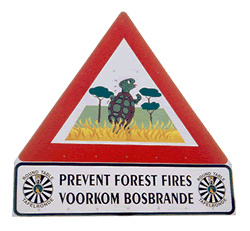Effects of fire on plants and animals
The effects of burning on biodiversity are often perceived to be negative, with concern about widespread death of animals particularly common. This general feeling is illustrated well in the US Forest Service and South African posters below. Think of the examples you've seen around Australia.



The reality is quite different, and in this section you will learn about the ways plants and animals can tolerate fire and how the effects of fire on biota vary in space and time. Responses to burning are dependent primarily on two things: first, on the fire characteristics, and second, on the life strategy of the organisms affected. Broad generalisations can therefore be hard to make. Some species may be negatively affected by fires while others benefit from fire. For any given fire there will be winners and losers.
If the aim of management is the conservation of biodiversity and ensuring healthy ecosystem functioning, it is crucial to gain a better understanding of what effect different fires and fire regimes have on biodiversity and ecosystem function.
![]()